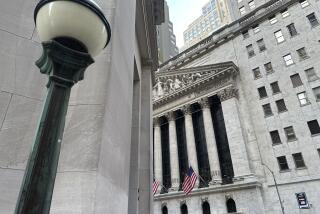Buyers lured by surge in Treasury yields
- Share via
The latest sell-off in Treasury bonds may have peaked as a steep jump in yields finally has lured buyers off the sidelines.
That could end the upward pressure on mortgage rates, at least for the time being.
Bonds rallied Thursday, driving interest rates lower, after the Treasury sold $11 billion in 30-year securities at a yield of 4.72% -- the highest auction rate in nearly two years but well below the 4.8% predicted by bond dealers in a survey by Bloomberg News.
“Something seems to have changed here” in terms of the market’s mentality, said Charles Comiskey, head of Treasury trading at HSBC Securities in New York. “The price action is telling you” that rates have reached at least a short-term high, he said.
The 10-year T-note yield, a benchmark for mortgage rates, dived to 3.86%, down sharply from the 3.99% that investors demanded on the $19 billion of new 10-year securities the Treasury sold Wednesday.
The surge in yields in recent days “has brought out a lot of value investors,” said George Goncalves, fixed-income strategist at bond dealer Cantor Fitzgerald in New York.
Longer-term Treasury yields have been rising steadily in recent months amid growing hopes for an economic recovery in the second half of the year. Some investors have been dumping low-yielding Treasuries in favor of stocks, junk bonds, commodities and other assets.
Treasury yields surged last Friday after the Labor Department said the economy lost fewer jobs than expected in May, feeding upbeat sentiment about a recovery.
The government’s relentless borrowing -- to fund its economic and financial-system bailout programs -- also has put upward pressure on bond yields as the supply of new securities has swamped the market.
The 30-year T-bond sale Thursday capped a total of $65 billion in debt sales by the Treasury this week. With this round of auctions over, the pressure is off the market for a bit, giving investors more incentive to buy, traders noted.
Still, there’s plenty more supply in the pipeline to fund a federal deficit expected to reach $1.7 trillion this year.
--
More to Read
Inside the business of entertainment
The Wide Shot brings you news, analysis and insights on everything from streaming wars to production — and what it all means for the future.
You may occasionally receive promotional content from the Los Angeles Times.










